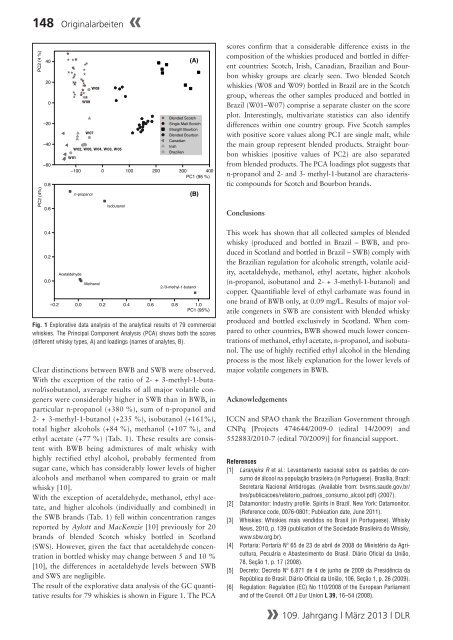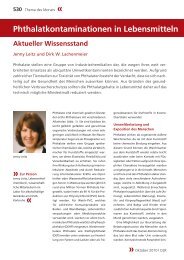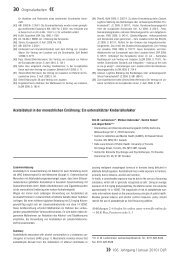Chemical composition of whiskies produced in ... - Dirk Lachenmeier
Chemical composition of whiskies produced in ... - Dirk Lachenmeier
Chemical composition of whiskies produced in ... - Dirk Lachenmeier
You also want an ePaper? Increase the reach of your titles
YUMPU automatically turns print PDFs into web optimized ePapers that Google loves.
148 Orig<strong>in</strong>alarbeiten «<br />
PC2 (4 %)<br />
PC2 (4%)<br />
40<br />
20<br />
0<br />
–20<br />
–40<br />
–60<br />
0.8<br />
0.6<br />
0.4<br />
0.2<br />
0.0<br />
Acetaldehyde<br />
W09<br />
W07<br />
n-propanol<br />
W08<br />
W02, W06, W04, W03, W05<br />
W01<br />
–100 0 100 200 300 400<br />
PC1 (95 %)<br />
Methanol<br />
Isobutanol<br />
Blended Scotch<br />
S<strong>in</strong>gle Malt Scotch<br />
Straight Bourbon<br />
Blended Bourbon<br />
Canadian<br />
Irish<br />
Brazilian<br />
2-/3-methyl-1-butanol<br />
–0.2 0.0 0.2 0.4 0.6 0.8 1.0<br />
PC1 (95%)<br />
Fig. 1 Explorative data analysis <strong>of</strong> the analytical results <strong>of</strong> 79 commercial<br />
<strong>whiskies</strong>. The Pr<strong>in</strong>cipal Component Analysis (PCA) shows both the scores<br />
(different whisky types, A) and load<strong>in</strong>gs (names <strong>of</strong> analytes, B).<br />
Clear dist<strong>in</strong>ctions between BWB and SWB were observed.<br />
With the exception <strong>of</strong> the ratio <strong>of</strong> 2- + 3-methyl-1-butanol/isobutanol,<br />
average results <strong>of</strong> all major volatile congeners<br />
were considerably higher <strong>in</strong> SWB than <strong>in</strong> BWB, <strong>in</strong><br />
particular n-propanol (+380 %), sum <strong>of</strong> n-propanol and<br />
2- + 3-methyl-1-butanol (+235 %), isobutanol (+161%),<br />
total higher alcohols (+84 %), methanol (+107 %), and<br />
ethyl acetate (+77 %) (Tab. 1). These results are consistent<br />
with BWB be<strong>in</strong>g admixtures <strong>of</strong> malt whisky with<br />
highly rectified ethyl alcohol, probably fermented from<br />
sugar cane, which has considerably lower levels <strong>of</strong> higher<br />
alcohols and methanol when compared to gra<strong>in</strong> or malt<br />
whisky [10].<br />
With the exception <strong>of</strong> acetaldehyde, methanol, ethyl acetate,<br />
and higher alcohols (<strong>in</strong>dividually and comb<strong>in</strong>ed) <strong>in</strong><br />
the SWB brands (Tab. 1) fell with<strong>in</strong> concentration ranges<br />
reported by Aylott and MacKenzie [10] previously for 20<br />
brands <strong>of</strong> blended Scotch whisky bottled <strong>in</strong> Scotland<br />
(SWS). However, given the fact that acetaldehyde concentration<br />
<strong>in</strong> bottled whisky may change between 5 and 10 %<br />
[10], the differences <strong>in</strong> acetaldehyde levels between SWB<br />
and SWS are negligible.<br />
The result <strong>of</strong> the explorative data analysis <strong>of</strong> the GC quantitative<br />
results for 79 <strong>whiskies</strong> is shown <strong>in</strong> Figure 1. The PCA<br />
(A)<br />
(B)<br />
scores confirm that a considerable difference exists <strong>in</strong> the<br />
<strong>composition</strong> <strong>of</strong> the <strong>whiskies</strong> <strong>produced</strong> and bottled <strong>in</strong> different<br />
countries: Scotch, Irish, Canadian, Brazilian and Bourbon<br />
whisky groups are clearly seen. Two blended Scotch<br />
<strong>whiskies</strong> (W08 and W09) bottled <strong>in</strong> Brazil are <strong>in</strong> the Scotch<br />
group, whereas the other samples <strong>produced</strong> and bottled <strong>in</strong><br />
Brazil (W01–W07) comprise a separate cluster on the score<br />
plot. Interest<strong>in</strong>gly, multivariate statistics can also identify<br />
differences with<strong>in</strong> one country group. Five Scotch samples<br />
with positive score values along PC1 are s<strong>in</strong>gle malt, while<br />
the ma<strong>in</strong> group represent blended products. Straight bourbon<br />
<strong>whiskies</strong> (positive values <strong>of</strong> PC2) are also separated<br />
from blended products. The PCA load<strong>in</strong>gs plot suggests that<br />
n-propanol and 2- and 3- methyl-1-butanol are characteristic<br />
compounds for Scotch and Bourbon brands.<br />
Conclusions<br />
This work has shown that all collected samples <strong>of</strong> blended<br />
whisky (<strong>produced</strong> and bottled <strong>in</strong> Brazil – BWB, and <strong>produced</strong><br />
<strong>in</strong> Scotland and bottled <strong>in</strong> Brazil – SWB) comply with<br />
the Brazilian regulation for alcoholic strength, volatile acidity,<br />
acetaldehyde, methanol, ethyl acetate, higher alcohols<br />
(n-propanol, isobutanol and 2- + 3-methyl-1-butanol) and<br />
copper. Quantifiable level <strong>of</strong> ethyl carbamate was found <strong>in</strong><br />
one brand <strong>of</strong> BWB only, at 0.09 mg/L. Results <strong>of</strong> major volatile<br />
congeners <strong>in</strong> SWB are consistent with blended whisky<br />
<strong>produced</strong> and bottled exclusively <strong>in</strong> Scotland. When compared<br />
to other countries, BWB showed much lower concentrations<br />
<strong>of</strong> methanol, ethyl acetate, n-propanol, and isobutanol.<br />
The use <strong>of</strong> highly rectified ethyl alcohol <strong>in</strong> the blend<strong>in</strong>g<br />
process is the most likely explanation for the lower levels <strong>of</strong><br />
major volatile congeners <strong>in</strong> BWB.<br />
Acknowledgements<br />
ICCN and SPAO thank the Brazilian Government through<br />
CNPq [Projects 474644/2009-0 (edital 14/2009) and<br />
552883/2010-7 (edital 70/2009)] for f<strong>in</strong>ancial support.<br />
References<br />
[1] Laranjeira R et al.: Levantamento nacional sobre os padrões de consumo<br />
de álcool na população brasileira (<strong>in</strong> Portuguese). Brasília, Brazil:<br />
Secretaria Nacional Antidrogas. (Available from: bvsms.saude.gov.br/<br />
bvs/publicacoes/relatorio_padroes_consumo_alcool.pdf) (2007).<br />
[2] Datamonitor: Industry pr<strong>of</strong>ile. Spirits <strong>in</strong> Brazil. New York: Datamonitor.<br />
(Reference code, 0076-0801; Publication date, June 2011).<br />
[3] Whiskies: Whiskies mais vendidos no Brasil (<strong>in</strong> Portuguese). Whisky<br />
News, 2010, p. 139 (publication <strong>of</strong> the Sociedade Brasileira do Whisky,<br />
www.sbw.org.br).<br />
[4] Portaria: Portaria Nº 65 de 23 de abril de 2008 do M<strong>in</strong>istério da Agricultura,<br />
Pecuária e Abastecimento do Brasil. Diário Oficial da União,<br />
78, Seção 1, p. 17 (2008).<br />
[5] Decreto: Decreto Nº 6.871 de 4 de junho de 2009 da Presidência da<br />
República do Brasil. Diário Oficial da União, 106, Seção 1, p. 26 (2009).<br />
[6] Regulation: Regulation (EC) No 110/2008 <strong>of</strong> the European Parliament<br />
and <strong>of</strong> the Council. Off J Eur Union L 39, 16–54 (2008).<br />
» 109. Jahrgang | März 2013 | DLR





